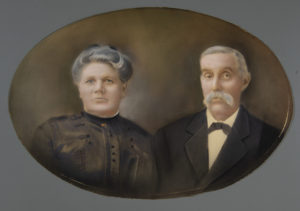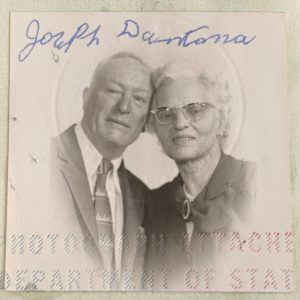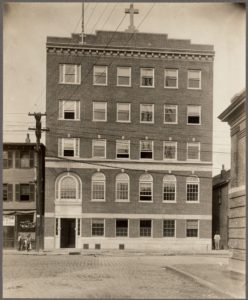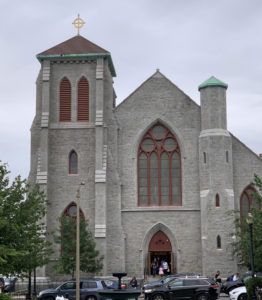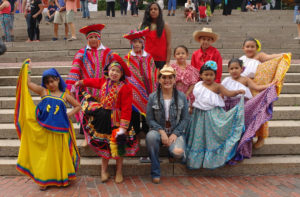“It is our home now”
in East Boston
The “Immigrant Grandmothers” mural was painted by the Mayor’s Mural Crew in 2017 using photos submitted by East Boston residents. It celebrates the lives and legacy of the women who built the predominantly immigrant community.
For almost 200 years, East Boston has been home to waves of immigrants. Many fled famine, poverty, persecution, violence, or natural disasters, but each immigrant’s story is unique. While some carried few possessions, a few came with degrees. All brought hope, courage, and determination to build a better life, especially for their children.
Each group created a community within East Boston, easing the challenging transition to the U.S. “Everyone looked out for each other,” recalls Marianne. “Having all our family here made it easier for my aunts and uncles,” explains Yesenia. “I fell in love with the neighborhood where many people speak Spanish,” adds Eugenia. Bodegas, bakeries, restaurants offer foods reminiscent of home. The close-knit enclaves have also helped immigrants continue cherished cultural traditions. “I want my kids to always know where we came from,” is a widely shared sentiment.
Some newcomers stay in East Boston a short while. But many families put down deep roots and have remained here for generations.
Irish natives Deborah Bresnahan and John Henry Callahan met at a Sacred Heart Church picnic and married a year later in 1876. The family stayed in East Boston for several generations.
Courtesy of Stephen Landrigan
Immigrants Joseph and Grazia D’Antona moved from the North End to East Boston. They bought a triple-decker, which they shared with their daughters’ families.
Courtesy of Marianne D’Antona Strong
In 1888, the Women’s Home Missionary Society founded the Immigrant Home on Marginal Street, to provide immigrant services. Today, Centro Presente and the East Boston Community Council are two of several organi-zations that support immigrants.
1912 photograph courtesy of the Boston Public Library, Boston Pictorial Archive
Children who participate in the Veronica Robles Cultural Center programs perform at various city events, including Hispanic Heritage Month. They are wearing traditional costumes from Colombia, Peru, and El Salvador. VROCC teaches, promotes and celebrates Latino cultures to bring people together.
Courtesy of the Veronica Robles Cultural Center
Sign Location
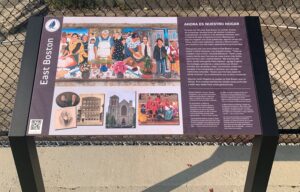
More …
Resources
- Caraballo, Jorge. “‘Donmatías, Massachusetts.’” Medium, December 9, 2015, https://medium.com/@jorgecaraballo/this-is-the-story-of-donmat%C3%ADas-a-colombian-town-with-a-very-unusual-migratory-behavior-9fb517ad2e23
- “East Boston—Exploring Boston’s Neighborhoods,” published by Boston Landmarks Commission, 1994.
- “The East Boston Immigration Station, A History,” https://www.massport.com/massport/community/initiatives/open-space-parks/the-east-boston-immigration-station/
- “Global Boston: A Portal to the Region’s Immigrant Past and Present”
- Imagine All the People
- Marchi, Rebecca. M. Legendary locals of East Boston, Massachusetts. Charleston, SC: Arcadia Publishing, 2015.
- Puleo, Stephen. The Boston Italians. Beacon Press, 2007.
- Scott, Phaedra. “Our Immigrant Abuelitas, Nonnas and Grandmothers Take Their Place in a New Mural,” WBUR News, December 8, 2017. https://www.wbur.org/news/2017/12/08/east-boston-immigrant-grandmothers-mural
- Thompson, Neal. “How the Kennedy dynasty began in East Boston with an Irish immigrant widow and her restless son.” Boston Globe Magazine, January 30, 2022.
- Veronica Robles Cultural Center https://veronicaroblesculturalcenter.org/
- Woods, Robert A. and Albert J. Kennedy, The Zone of Emergence: Observations of the Lower Middle and Upper Working Class Communities of Boston, 1905-1914. Cambridge, Mass.: MIT Press, 1962, 187-219.
Acknowledgments
Warm thanks to the dozens of people–newcomers to Boston and descendants of immigrants–who shared their stories.
And thank you to Boston College Professor Marilynn Johnson for her expertise and deep commitment to ensuring immigrant stories are shared and celebrated.


